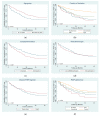Loss to Follow-Up from HIV Pre-Exposure Prophylaxis Care in Men Who Have Sex with Men in West Africa
- PMID: 36366478
- PMCID: PMC9695325
- DOI: 10.3390/v14112380
Loss to Follow-Up from HIV Pre-Exposure Prophylaxis Care in Men Who Have Sex with Men in West Africa
Abstract
Loss to follow-up (LTFU) from HIV pre-exposure prophylaxis (PrEP) care compromises the goal of HIV elimination. We investigated the proportion of LTFU and associated risk factors among men who have sex with men (MSM) enrolled in a PrEP demonstration project in Burkina Faso, Côte d'Ivoire, Mali, and Togo. CohMSM-PrEP, a prospective cohort study, was conducted between November 2017 and June 2021 in community-based clinics. MSM aged 18 years or older at substantial risk of HIV infection received a comprehensive prevention package, including PrEP and peer education. LTFU was defined as not returning to the clinic for six months. Associated risk factors were investigated using a time-varying Cox's model. Of 647 participants followed up for a median time of 15 months, 372 were LTFU (57.5%). LTFU was associated with younger age (adjusted hazard ratio [95% Confidence Interval]; 1.50 [1.17-1.94]), unemployment (1.33 [1.03-1.71]), depression (1.63 [1.12-2.38]), and perceiving no HIV risk with stable male partners (1.61 [1.23-2.10]). Contacting peer educators outside of scheduled visits was protective (0.74 [0.56-0.97]). Our findings show that LTFU from PrEP care in West African MSM is a major challenge to achieving HIV elimination, but that the involvement of peer educators in PrEP delivery helps to limit LTFU by providing users with adequate support.
Keywords: HIV/AIDS; MSM; PrEP; West Africa; community-based research; key populations; pre-exposure prophylaxis.
Conflict of interest statement
The authors declare no conflict of interest. The funders had no role in the design of the study; in the collection, analyses, or interpretation of data; in the writing of the manuscript; or in the decision to publish the results.
Figures




References
-
- UNAIDS UNAIDS Data 2021. [(accessed on 11 May 2022)]. Available online: https://www.unaids.org/en/resources/documents/2021/2021_unaids_data.
-
- United Nations United Nations Political Declaration on Ending AIDS Sets World on the Fast-Track to End the Epidemic by 2030. [(accessed on 1 June 2022)]. Available online: https://www.unaids.org/en/resources/presscentre/pressreleaseandstatement....
-
- United Nations United Nations Sustainable Development Goals (SDGs) 3: Ensure Healthy Lives and Promote Wellbeing for All at All Ages. [(accessed on 19 September 2022)]. Available online: https://www.un.org/sustainabledevelopment/health/
Publication types
MeSH terms
Substances
LinkOut - more resources
Full Text Sources
Medical
Miscellaneous

